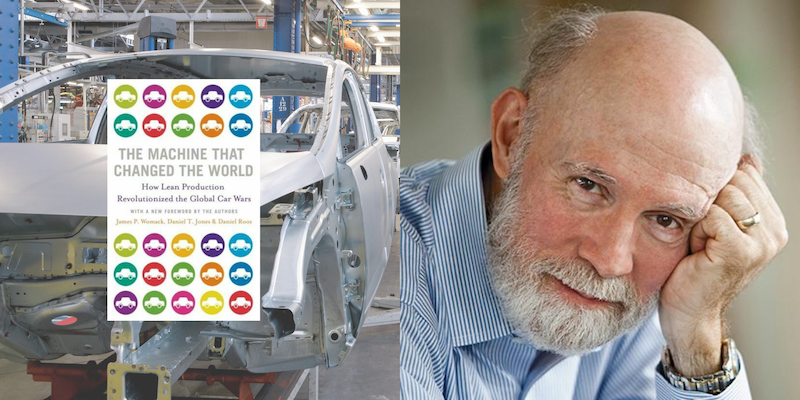
Our editor sits down with lean farmer Ben Hartman
INTERVIEW – Ben Hartman has used lean in his micro-farm in Indiana for six years. Not only did he find in it a way to support his family doing what he loves, he might have also discovered how to transform our food system.
Interviewee: Ben Hartman, Clay Bottom Farm, Indiana
Roberto Priolo: The story of how you got to learn about lean is a fantastic example of yokoten, or cross-pollination. Can you tell us a bit about it?
Ben Hartman: The communities in the area I am from – in northern Indiana – were founded by Mennonites and Amish in the 18th century. As Mennonites, we have something of a genetic predisposition to not wasting anything. When I was first introduced to lean ideas, I immediately saw many facets of the Mennonite culture in them. In fact, I realized we had been applying lean ideas in our farm for a very long time, without really knowing it. However, around six years ago, a long-time CSA customer of ours (CSA customers pay us at the beginning of the growing season to supply them with produce), Steve Brenneman, told me about this thing called “lean” that he was using at his Aluminum Trailer Company. He offered to come around and introduce us to some of the key concepts. My wife and I talked it over, and at first we were reluctant – because people love to tell farmers what to do, but also because, historically, industrial methods had not succeeded when applied to farming (in fact, it is industrial farming that has largely contributed to problems like climate change and dietary health issues). We also thought there was too much variability in our processes for a single system to work. Steve pushed back and gave some compelling reasons to give it a shot – primarily, he said that we needed capacity and that lean could give it to us by improving the process (and without throwing more money at the business). Eliminating waste to build capacity… that was my hook.
RP: With the promise of increased capacity comes the opportunity to grow exponentially. Was there ever a temptation to turn yourself into a big farmer that sells his products to customers thousands of miles away?
BH: Lean has certainly brought us economic benefits, but what we really wanted to do was to stay home and raise our kids on a farm. I want to be a small farmer, and I love the work that comes with it. We need to get local, healthy food in our community, and lean is a fantastic tool for that.
The deck is stacked against small farmers – in the US, we have a $5 billion farm subsidy package that benefits large multi-millionaire farmers – but lean is that fifth gear in your tractor that you didn’t know you had and that can make you competitive. It is the only way to run a small farm business and make a career out of it.
RP: Tell me more about the wider agricultural context, please.
BH: Let me use corn as an example, because I grew up on a corn farm, even though the same is largely true for all commodity crops. Within a generation, we have gone from producing about five billion bushels of corn a year to producing about 15 billion. We have become very good at mass producing crops, and we need to do something with this excess: that’s why we end up pushing it to customers in the form of corn syrup, plastics, diapers, etc. It’s also making us sick: trace the overproduction of corn and the increase in diabetes (the health epidemic of our time) on a chart, and the two lines will go together. The system works for the 1% who are producing the food, but not for the rest of us.
It’s important to set ethical boundaries around farming. We have important questions to ask about our food system: what food do we want poor people in our communities to have access to? What kind of planet do we want to live in? Lean can help answer these questions.
RP: What I love about this story is that not only does it show micro-farmers around the world a way to make a good living out of just one acre of land, but it also offers a way to solve some of the most pressing systemic issues the world is facing.
BH: One of the most powerful things about lean ideas is that they are universal. The seven types of waste that Taiichi Ohno identified are universal concepts: you will find each of them on every farm in the world. I am not surprised: many of the early Toyota workers were actually farmers!
RP: What does “harvesting as market ready as possible” look like in practice?
BH: Say you are harvesting broccoli. In a traditional farming schedule, you start harvesting at 3-4 in the morning. You harvest tens of thousands of heads of broccoli, stick them in a walk-in cooler, and then spend a few days calling up your customers to try and push the product. This process is classic batch-and-queue. What we are doing is taking orders on daily basis, harvesting on a daily basis precisely the amounts we need, and we don’t even have a walk-in cooler. (We live within 1.5 miles of all our customers.) We try to harvest, clean and package while the item is in the worker’s hands. So, we harvest a head of broccoli and we clean it and package it on the spot (we carry supplies with us on the field). Instead of “touching the food” eight to ten times before it reaches the customer, we only handle it three or four.

RP: You have been on the journey for six-seven years now. What was the turning point in your transformation?
BH: One of the key moments for us was around the time Steve came around. We used to have regular Pizza and Weedparties at the farm: college students would come around, weed our farm and we’d buy them pizza afterwards. (My wife rightly thought that the name would lure them in.) One day, around half an hour before the college students came in, a gale-force wind blew our greenhouse onto the roof of the barn. The students had to help us to dismantle the whole thing. (Needless to say, this was pure waste). Following that, Steve introduced us to the idea of the 5 whys. Why did we need a greenhouse in the first place? We realized that the root cause of the problem was that we were trying to grow our business too quickly. I grew up with the idea that a farm has to grow bigger every year to “make it”, but it was clear that that growth mindset wasn’t working for us.
RP: Another thing I find really interesting about your story is how simple your approach is – you use a few tools and a few principles, and the benefits these have brought you were incredible. Why is that?
BH: My brother is a research librarian and I asked him to go back in history as much as he could to find out how the Japanese grew their food. He found a scroll from about a thousand years ago that detailed a very simple food production system. This made me realize that throughout human history we have been growing food and feeding the world using just a few tools – baskets, grubbing hoes, knives – and a few inputs – like manure or compost. The Japanese waste-free thinking was incredibly extreme (they would reuse everything, including chopsticks and the dirt they could scoop up from the floor in their houses), and they found a way to turn muda into something that could support food production. It’s very simple, and very inspirational. So, I went about designing a system allowing us to produce a lot of food using just a few tools and simple processes. It turns out that it’s fun and way more profitable.
RP: Lean tools are simple, and your experience on the farm really shows that. What was your approach to using them?
BH: People from the Second World War generation never threw anything away. And that worked for their generation – it got them through the Great Depression. But times have changed, and the task of our generation – whether on a farm or in any other business – is to edit relentlessly. Our generation has access to too much stuff, and we need to choose carefully the few things that we really need in life. We had some serious editing to do ourselves, and it made sense that the first thing to tackle would be 5S. We went around the farm, touched every item we had (and we had a lot of items) and asked a simple question: “Did you add value for the customer this past growing season?” If we had to scratch our head and think it over, we decided that it was time to chuck that item. It turned out we just need a small handful of tools. Today, we could move most of our farm tools in the back of a truck.

RP: Your efforts to understanding customer value were incredible. Can you take us through how you did it?
BH: Getting to know our customers and starting to deliver to them the products they want was step number two, after 5S. We asked all of our customers three very simple questions: what do you want? When do you want it? How much of it do you want? I knew that this would give us an advantage over potential competition, and it’s a way to respect customers. To reach out to our entire customer base typically takes us a day or two every winter. The more precisely we can answer those questions – and deliver on the answers – the more profitable we will be as a business. It’s not rocket science, and yet so few businesses start with the customer!
It’s important to remember that listening to customers is a continuous process. We constantly go to our customers, to find out if their needs have changed. We get very specific with the questions we ask, because we want our customers to be excited about the food we deliver to them every week. We need to have a super-clear understanding of what they need. Once you get that, you can start improving your processes in order to deliver that value.

Buy a copy of The Lean Farm here.
THE INTERVIEWEE

Read more


FEATURE – In the age of complexity and disruption, flowing value to customers as quickly as possible is critical. The new Toyota Flow System strives to address this issue.


ROUNDUP – Our editor discusses A3 Thinking and its various uses, curating a list of the best Planet Lean articles published on this topic over the years.


FEATURE – Reflecting on some of the work he’s recently observed, the author discusses what lean thinking teaches us about making life easier for the value creators in our organizations.


INTERVIEW – Thirty years ago, a book introduced lean thinking to the world, started a global movement and transformed business forever. Our editor caught up with one of the authors.

